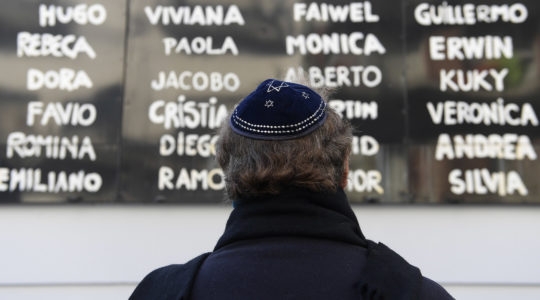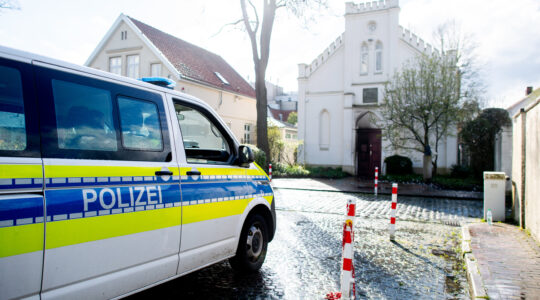BUDAPEST, Hungary (JTA) — Andras Mayer is on a mission to get the Teleki Square shtiebel on the map — literally.
Renovations have started on the little Budapest synagogue, which tour guides generally pass over when visiting Jewish sites.
“We’ll do whatever it takes,” says Mayer, 37, one of the young intellectuals who worship regularly at the shtiebel — literally, Yiddish for “little room” — in the center of the Hungarian capital. “We are on a cultural mission now, documenting this last bit of an almost completely lost culture.”
A Chabad rabbi and some elderly Jews are joining Mayer and a group of young, not overly observant Jews in their quest to rebuild the century-old shtiebel.
“We became religious on Saturdays from 9 to 11 a.m. in order to help the old people who prayed here,” Mayer says. Smiling, he adds, “Now they are not around anymore, we kept on coming and even attracted girls and kids.”
Despite its central location, the Orthodox synagogue remained on the fringe of the Hungarian Jewish community’s attention because of its location in one of the poorest neighborhoods of Budapest. It was neglected for so long that the young people who started going there a decade ago were able to shape it into a relatively independent community of their own.
The Hungarian Orthodox Union provides the synagogue with basic funding and pays the bills.
The minyan meets Saturday mornings and on major holidays. Members say Teleki is the only synagogue in Hungary where prayers are recited following a rare Sephardic nusach, or liturgy, adding special tunes unique to the community.
Poor Jewish migrants settled in the neighborhood of Teleki beginning in the 1850s, most of them making a living at the flea market selling throw-away goods, geese, spices, vegetables and rugs.
The shtiebel had been one of 17 synagogues in the neighborhood, each of which had its own group of vendor members. Pogroms in October 1944 destroyed several small shtiebels, although Zionist youth fought back at an inn for market vendors and injured several German soldiers.
Peter Stein, whose family had been shtiebel regulars for five generations, said the Chortkow Chasidim from Galicia started the Teleki Square shtiebel around the turn of the 20th century.
Stein says that when he was a child in the 1950s, the shtiebel was full of congregants. He recalls that his father, upon returning from the Auschwitz death camp, rushed to the shtiebel to see if it was still there even before he went home to check on whether his home and family were intact.
By the 1990s, while a Jewish renaissance was taking place elsewhere in Hungary, the shtiebels and the Jewish establishments were closed in Teleki as the remaining Jews moved away.
The Teleki Square shtiebel is the last in operation and houses the remnants from the other synagogues — kabbalistic paintings, religious objects, Torah scrolls, old armchairs and chandeliers.
“We were surprised to find not only a beautiful bimah, crumbling books and prayer stands, but also suitcases full of clothes, shoes, calendars, dishes and other personal items from the time of the Shoah,” Mayer says.
The Hungarian Orthodox Union has donated a few thousand dollars to repaint the shtiebel, but members are looking into additional funding to repair the Torah scrolls and install heating, a bathroom and a kitchen.
They want to start Torah classes with Chabad Rabbi Sholom Hurwitz, who became the religious leader of the community, although the shtiebel is not connected to Chabad-Lubavitch. The rabbi’s wife prepares kosher cholent and cookies for visitors, but shtiebel members want to do more.
Speaking about the renovations, Mayer’s brother, Gabor, says, “We are doing it very carefully, respectfully and gradually in order to keep the spirit of the shtiebel alive. We want to maintain it the way we found it a decade ago.”
Andras Mayer says, however, that “the question is what was its original state — layers and layers of paint have been added.”
As a first step, Andras says, the rotten entrance door and pipes were replaced. The Jakab Glaser Memorial Foundation, named for the man Mayer calls the engine of the minyan, has been established to help pay for the work.
Glaser, a carpenter also known as Glaser bacsi, died recently.
“Glaser bacsi, even at age 92, used to start making calls on Wednesday to recruit a minyan for Saturday morning,” Mayer says. “Over the years he attracted a group of young men whose ritual became to hang out in shul, then go out with Glaser bacsi for cakes and coffee to a nearby pastry shop after services and listen to his somewhat funny, somewhat horroristic stories of a world that’s been lost.
“We loved him for his courage, knowledge and sense of humor,” says Gabor Mayer, 28, who helped out around the shtiebel and eventually took over its leadership.
It is Gabor who now makes any calls needed for a minyan, though they are rare because there are a growing number of devoted congregants. He had assisted Glaser on a personal level, tending to health care needs and buying his lottery tickets.
Talking about the young people now reviving the minyan, Gabor says, “Nobody will know our names in a few years, just like we don’t know who those old people were on those old pictures we found, for whom this shtiebel had been a meaningful part of their lives.”
The shtiebel, he adds, “will live on and remain the same as it was yesterday, today or tomorrow.”





